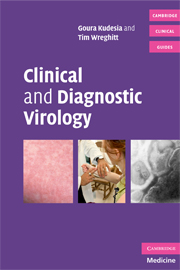Book contents
- Frontmatter
- Contents
- List of plates
- Preface
- Acknowledgements
- SECTION 1 INDIVIDUAL VIRUSES
- SECTION 2 OTHER RELATED AGENTS
- SECTION 3 CLINICAL SYNDROMES
- SECTION 4 DIAGNOSTIC TECHNIQUES
- 46 Sending specimens to the laboratory
- 47 Serological techniques
- 48 Virus detection
- 49 Molecular techniques
- SECTION 5 PATIENT MANAGEMENT
- Index
- Plate section
49 - Molecular techniques
Published online by Cambridge University Press: 07 December 2009
- Frontmatter
- Contents
- List of plates
- Preface
- Acknowledgements
- SECTION 1 INDIVIDUAL VIRUSES
- SECTION 2 OTHER RELATED AGENTS
- SECTION 3 CLINICAL SYNDROMES
- SECTION 4 DIAGNOSTIC TECHNIQUES
- 46 Sending specimens to the laboratory
- 47 Serological techniques
- 48 Virus detection
- 49 Molecular techniques
- SECTION 5 PATIENT MANAGEMENT
- Index
- Plate section
Summary
Molecular techniques are those that use the principles of molecular biology to detect viral genomes (RNA or DNA). The use of these techniques has been commonplace in virology and has led to the discovery of new viruses, the study of viral resistance, designing of new antiviral drugs and vaccines.
Many are in use in routine diagnostic laboratories to aid viral diagnosis. Those that are in current and common use are described.
DNA or RNA hybridization
A complementary RNA or DNA probe is used to bind to the DNA or RNA viral genome. The DNA–RNA hybrid can then be detected using a labelled monoclonal antibody. This technique can be used on tissue samples, in which case it is called in situ hybridization, or the viral genome can first be transferred on to a blotting paper (dot blot hybridization).
To obtain a positive reaction, high numbers of copies of viral DNA or RNA are required; therefore the technique is relatively insensitive and has been largely superseded by nucleic acid amplification techniques (NAATs).
Polymerase chain reaction (PCR)
This was the first NAAT to be described. It is a technique by which a single copy of DNA or RNA can be amplified more than a million times. To detect RNA viruses, RNA has to be first transcribed to complementary DNA by means of an enzyme called reverse transcriptase; this type of PCR is referred to as reverse transcription PCR (RT PCR).
- Type
- Chapter
- Information
- Clinical and Diagnostic Virology , pp. 217 - 220Publisher: Cambridge University PressPrint publication year: 2009



